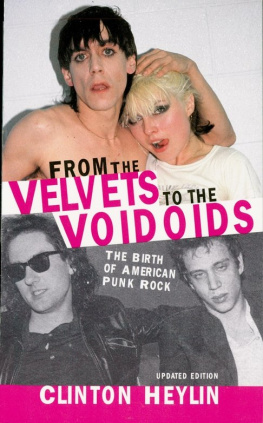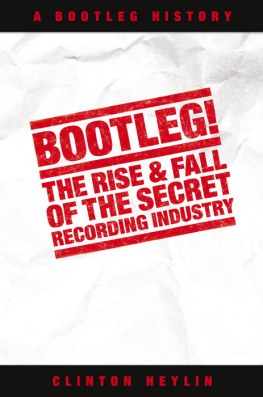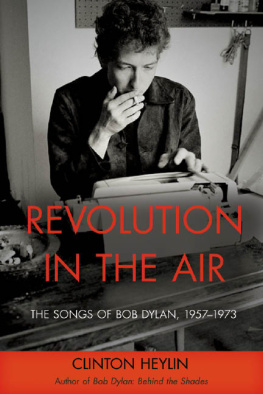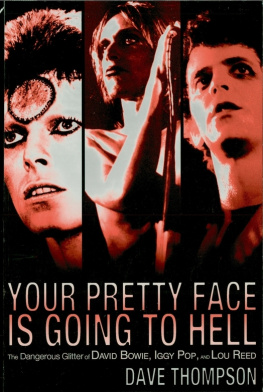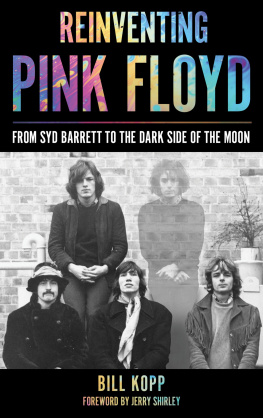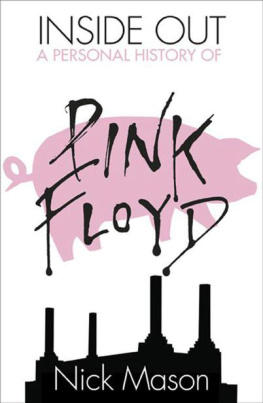ALL THE MADMEN
Also by Clinton Heylin
So Long As Men Can Breathe: The Untold Story of Shakespeares Sonnets
Still on the Road: The Songs of Bob Dylan vol. 2 (19742008)
Revolution In The Air: The Songs of Bob Dylan vol. 1 (195773)
The Act Youve Known For All These Years:
A Year In The Life of Sgt. Pepper and Friends
Babylons Burning: From Punk to Grunge
From The Velvets To The Voidoids: The Birth of American Punk
All Yesterdays Parties: The Velvet Underground in Print 196671 [editor]
Despite The System: Orson Welles versus The Hollywood Studios
Bootleg The Rise & Fall of the Secret Recording Industry
Can You Feel The Silence? Van Morrison: A New Biography
No More Sad Refrains: The Life & Times of Sandy Denny
Bob Dylan: Behind The Shades Take Two
Dylans Daemon Lover: The Tangled Tale of a 450-Year-Old Pop Ballad
Dylan Day By Day: A Life In Stolen Moments
Never Mind The Bollocks, Heres The Sex Pistols
Bob Dylan: The Recording Sessions 196094
The Great White Wonders: A History of Rock Bootlegs
The Penguin Book of Rock & Roll Writing [editor]
Gypsy Love Songs & Sad Refrains:
The Recordings of Sandy Denny & Richard Thompson
Rise/Fall: The Story of Public Image Limited Joy Division: Form & Substance [with Craig Wood]

For Scott, a true custodian of the vocal era.
Constable & Robinson Ltd
5556 Russell Square
London WC1B 4HP
www.constablerobinson.com
First published in the UK by Constable,
an imprint of Constable & Robinson Ltd, 2012
Copyright Clinton Heylin, 2012
The right of Clinton Heylin to be identified as the author of this work has been asserted by him in accordance with the Copyright, Designs and Patents Act 1988. All lyrics and secondary material is quoted for study review or critical purposes.
All rights reserved. This book is sold subject to the condition that it shall not, by way of trade or otherwise, be lent, re-sold, hired out or otherwise circulated in any form of binding or cover other than that in which it is published and without a similar condition including this condition being imposed on the subsequent purchaser.
A copy of the British Library Cataloguing in
Publication data is available from the British Library
ISBN: 978-1-84901-880-7
eISBN: 978-1-78033-078-5
Printed and bound in the UK
1 3 5 7 9 10 8 6 4 2
Preface: Whom The Gods Destroy...
The frequency in the modern world of works of art that explode out of madness no doubt proves nothing about the reason of that world, about the meaning of such works, or even about the relations formed and broken between the real world and the artists who produced such work. And yet this frequency must be taken seriously...
Michel Foucault, Madness and Civilization, 1967
The acid brought out his latent madness. Im sure it was the latent madness which gave him his creativity. The acid brought out the creativity, but more important it brought out the madness.
Peter Jenner, talking about Syd Barrett, A Day in the Life, 1988
The Sixties has been defined by any number of those so-and-so met whatsisname moments: the day John met Paul; the night Dylan turned The Beatles on; the evening Kennedy purportedly trounced Nixon on the presidential TV debate. But perhaps the strangest of strange meetings was the day in late 1967 when (anti-)psychiatrist R.D. Laing encountered Pink Floyd frontman Syd Barrett, an event so unlikely that no one can agree on what or whether it happened.
Dave Gilmour has claimed it never did, but then he wasnt even in Pink Floyd at the time. Drummer Nick Mason, in his own memoir, wrote that Barrett refused to go in to see Laing, sitting in the car instead. But manager Peter Jenner, whose idea it was and who perhaps has less of an axe to grind, insists that Syd and Laing did talk. Jenner had become convinced that Syd was showing worrying signs of schizophrenia, and Laing was someone he personally knew (he had played a minor role in the establishment of the London Free School in the summer of 1966, where Floyd first developed their psychedelic show at a weekly residency Jenner organized). It was both a collision of pop culture with academia and the summation of a particular 1960s sensibility, as the ley lines of psychiatry and psychedelia crossed for the first and last time.
Syds slip into said mental state had been as sudden as it was unexpected. In the summer of 1967, the season of Love, sitting high in the charts with the Floyds otherworldly second single, See Emily Play (hard on the heels of the knicker-nicking Arnold Layne), and awaiting the imminent release of their inspirational debut LP, Piper at the Gates of Dawn fittingly named after a chapter in The Wind in the Willows Barrett had the whole wide world at his feet. But his own inner world was closing in. In a single weekend at the end of July, so the story goes, he went from been the pied piper of English pop to Mr Madcap.
Earlier in the week he had turned up to mime along to See Emily Play on Top of the Pops, and for the first time he appeared both dishevelled and distracted to the rest of the band, if not of another world. Then on the Friday, scheduled to record an all-important Saturday Club radio session, again for the BBC, he turned up in body but not in mind and, as the studio manager complained to Jenner, left the studio without [even] completing the recording of the first number. This simply wasnt done. Later the same day he arrived at a jam-packed UFO (pronounced U-Fo) for the closing night of the original underground club, where a harassed Joe Boyd, the club founder, looked into his friends eyes and saw black holes (an image Roger Waters would later appropriate for his own eulogy to Barrett, Shine On You Crazy Diamond). As Boyd recently noted, he was not wholly surprised, having realized for some time that if you did [LSD] every day, you were jeopardizing the wires that held everything together in your mind.
Throughout that nights performance, according to drummer Nick Mason, Syd stood with his arms hung by his side... occasional[ly] strumming. Keyboardist Rick Wright recalled things slightly differently, but with the same outcome: He went missing for the whole weekend and when he reappeared again... he was a totally different person. A week later, the whole band assembled at Abbey Road to record a third single to consolidate the success of See Emily Play, and they were relying on Syd to deliver the goods again. The song he arrived with, a little burnt-out but ready to record, was the prophetic Scream Thy Last Scream: Fling your arms madly, old lady with a daughter /... Flitting and hitting and fitting, quack quack. Gone for good were the adult fairy stories and space-age explorations of yore, replaced by such cerebral ministrations.
At a session in September, Barrett delivered his next song, which was stranger still. Vegetable Man seemed almost like a celebration of catatonia (Its what I wear its what you see / It must be me, its what I am / Vegetable man). As Jenner recalls: He sat there and just described himself. The band were now really starting to worry. Had they given up lucrative careers as architects for this?! Or was the ever-playful Syd just messing with their minds? It certainly seemed that way when he proceeded to teach them his most dissociated song to date, Jugband Blues, which he wanted to record with a bridge that incorporated a brass section playing completely at random, before everything was washed away, leaving just a single guitar strumming and the following sung queries: What exactly is a dream? / And what exactly is a joke... ?


